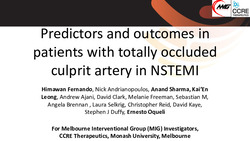Please use this identifier to cite or link to this item:
http://hdl.handle.net/11054/1329| Title: | Incidence, predictors and outcomes in patients with totally occluded culprit artery in NSTEMI. |
| Author: | Oqueli, Ernesto Fernando, Himawan Adrianopoulos, Nick Sharma, Anand Leong, Kai'En Ajani, Andrew Clark, David Freeman, Melanie Sebastian, M Brennan, Angela Selkrig, Laura Reid, Christopher Kaye, David Duffy, Stephen J. |
| Issue Date: | 2018 |
| Conference Name: | Ballarat Health Services 2018 Annual Research Symposium: research partnerships for population, people and patients; celebrating our research partnerships with the community in the Grampians region |
| Conference Date: | November 29th |
| Conference Place: | Ballarat |
| Abstract: | Background It is unclear whether patients without ST elevation on ECG with totally occluded culprit arteries have poorer outcomes than other Non-ST elevation myocardial infarction patients and compared to ST elevation myocardial infarction Objectives/Aims To establish the incidence of patients with Non-ST elevation myocardial infarction (NSTEMI) with occluded culprit artery and compare outcomes versus NSTEMI patients in general and ST-elevation myocardial infarction (STEMI) patients. Method Patients admitted with a NSTEMI (excluding out of hospital cardiac arrest) within the Melbourne Interventional Group (MIG) registry between 2005-2017 with single lesion PCI were included. The primary endpoint was major adverse cardiac events (MACE) at 30 days between NSTEMI patients with and without occluded culprit arteries. Secondary endpoints included 12-month mortality and MACE. Secondary analysis compared outcomes between STEMI patients and NSTEMI patients with occluded artery. Results 6829 patients had single lesion NSTEMIs of which 954 (13.97%) had occluded culprit arteries. Most culprit arteries were non-LAD (RCA 39.2%, LCx 33.2% vs. LAD 25.9%). There were higher rates of cardiogenic shock and left ventricular dysfunction in the occluded artery group. 30-day MACE was higher in the occluded artery group (6.7% vs 3.8%) with a hazard ratio of 1.93 with higher cardiac mortality, target lesion and vessel revascularisation, no-reflow and Glycoprotein IIb/IIIa use. However, long term mortality was not higher than the overall NSTEMI cohort. All-cause mortality and 30-day MACE were higher in the STEMI cohort than the NSTEMI occluded artery group. Implications/Outcomes for Planned Research Project This research project suggests that patients with occluded culprit arteries likely require closer observation post PCI and potentially a longer period of observation in hospital post procedure. Final Thoughts NSTEMI with occluded artery patients represent a more unstable subgroup early after presentation however with appropriate treatment long term risks are not increased. They represent a lower risk group than STEMI patients despite potential delays in emergent percutaneous intervention due to lack of ST elevation. |
| URI: | http://hdl.handle.net/11054/1329 |
| Internal ID Number: | 01273 |
| Health Subject: | MYOCARDIAL INFARCTION OCCLUDED CULPRIT ARTERIES |
| Type: | Conference Presentation |
| Appears in Collections: | Research Output |
Files in This Item:
| File | Description | Size | Format | |
|---|---|---|---|---|
| Himawan FERNANDO NSTEMI.pdf | ppt | 372.52 kB | Adobe PDF |  View/Open |
Items in DSpace are protected by copyright, with all rights reserved, unless otherwise indicated.
